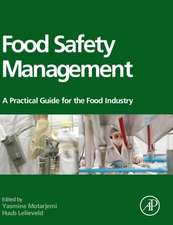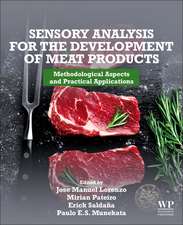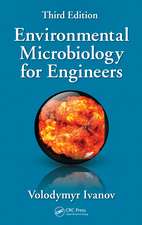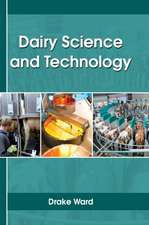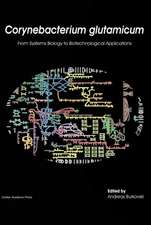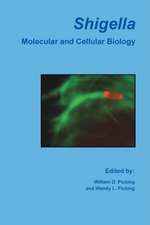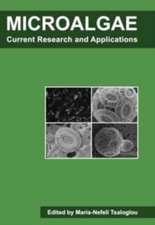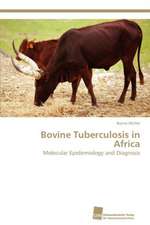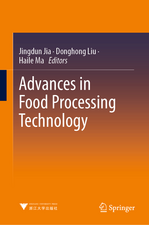Yeasts in Natural Ecosystems: Ecology
Editat de Pietro Buzzini, Marc-André Lachance, Andrey Yurkoven Limba Engleză Hardback – 18 oct 2017
Yeasts are the smallest eukaryotic organisms successfully growing under a wide range of environmental conditions. They constantly modify the environment through their own metabolic activities. Although yeasts are among the earlier colonizers of nutrient-rich substrates, their role in ecosystem processes is not limited to the consumption and transformation of simple sugars. They also engage in close relationships with animals, plants and other fungi in the environment as mutualists, competitors, parasites and pathogens. This book reviews the diversity of biological interactions and roles of yeasts in ecosystems and summarises recent concepts and tools developed in community ecology. All of the chapters were written by leading international yeast research experts, and will appeal to researchers and advanced students in the field of microbial ecology.
| Toate formatele și edițiile | Preț | Express |
|---|---|---|
| Paperback (2) | 784.61 lei 38-44 zile | |
| Springer International Publishing – 17 aug 2018 | 784.61 lei 38-44 zile | |
| Springer International Publishing – 17 mai 2018 | 1391.36 lei 6-8 săpt. | |
| Hardback (2) | 951.14 lei 6-8 săpt. | |
| Springer International Publishing – 18 oct 2017 | 951.14 lei 6-8 săpt. | |
| Springer International Publishing – 18 oct 2017 | 1396.74 lei 6-8 săpt. |
Preț: 951.14 lei
Preț vechi: 1159.94 lei
-18% Nou
Puncte Express: 1427
Preț estimativ în valută:
182.03€ • 189.33$ • 150.27£
182.03€ • 189.33$ • 150.27£
Carte tipărită la comandă
Livrare economică 14-28 aprilie
Preluare comenzi: 021 569.72.76
Specificații
ISBN-13: 9783319615745
ISBN-10: 3319615742
Pagini: 250
Ilustrații: XII, 293 p. 20 illus., 4 illus. in color.
Dimensiuni: 155 x 235 mm
Greutate: 0.61 kg
Ediția:1st ed. 2017
Editura: Springer International Publishing
Colecția Springer
Locul publicării:Cham, Switzerland
ISBN-10: 3319615742
Pagini: 250
Ilustrații: XII, 293 p. 20 illus., 4 illus. in color.
Dimensiuni: 155 x 235 mm
Greutate: 0.61 kg
Ediția:1st ed. 2017
Editura: Springer International Publishing
Colecția Springer
Locul publicării:Cham, Switzerland
Cuprins
Notă biografică
Prof. Dr. Pietro Buzzini, Industrial Yeasts Collection DBVPG, Department of Agricultural, Borgo XX Giugno 74, 06121
Perugia, Italy
Prof. Dr. Marc-André Lachance, University of Western Ontario, Department of Biology, 1151 Richmond St, London
N6A 5B7, Canada
Dr. Andrey Yurkov, Leibniz-Institut DSMZ, Inhoffenstr. 7B, 38124 Braunschweig, Germany
Perugia, Italy
Prof. Dr. Marc-André Lachance, University of Western Ontario, Department of Biology, 1151 Richmond St, London
N6A 5B7, Canada
Dr. Andrey Yurkov, Leibniz-Institut DSMZ, Inhoffenstr. 7B, 38124 Braunschweig, Germany
Textul de pe ultima copertă
This book presents an up-to-date review of the ecology of yeast communities in natural ecosystems. It focuses on their biological interactions, including mutualism, parasitism, commensalism and antagonistic interactions, and is closely connected with the volume Yeasts in Natural Ecosystems: Diversity by the same editors.
Yeasts are the smallest eukaryotic organisms successfully growing under a wide range of environmental conditions. They constantly modify the environment through their own metabolic activities. Although yeasts are among the earlier colonizers of nutrient-rich substrates, their role in ecosystem processes is not limited to the consumption and transformation of simple sugars. They also engage in close relationships with animals, plants and other fungi in the environment as mutualists, competitors, parasites and pathogens. This book reviews the diversity of biological interactions and roles of yeasts in ecosystems and summarises recent concepts and tools developed in community ecology. All of the chapters were written by leading international yeast research experts, and will appeal to researchers and advanced students in the field of microbial ecology.
Yeasts are the smallest eukaryotic organisms successfully growing under a wide range of environmental conditions. They constantly modify the environment through their own metabolic activities. Although yeasts are among the earlier colonizers of nutrient-rich substrates, their role in ecosystem processes is not limited to the consumption and transformation of simple sugars. They also engage in close relationships with animals, plants and other fungi in the environment as mutualists, competitors, parasites and pathogens. This book reviews the diversity of biological interactions and roles of yeasts in ecosystems and summarises recent concepts and tools developed in community ecology. All of the chapters were written by leading international yeast research experts, and will appeal to researchers and advanced students in the field of microbial ecology.
Caracteristici
Presents in a single volume a comprehensive overview of all aspects of yeast ecology
Provides new insights into the colonization and persistence of yeasts in natural ecosystems
Discusses the ability of yeasts to interact with different organisms and to modify the environment through their metabolic activities
Provides new insights into the colonization and persistence of yeasts in natural ecosystems
Discusses the ability of yeasts to interact with different organisms and to modify the environment through their metabolic activities

